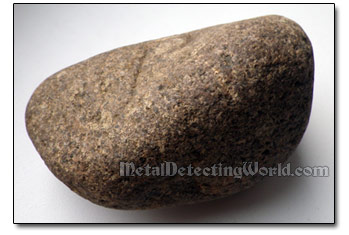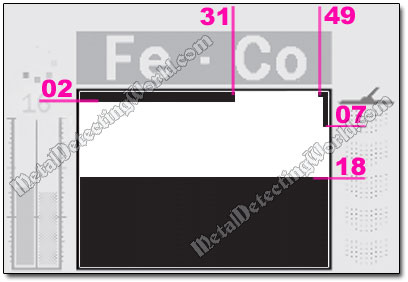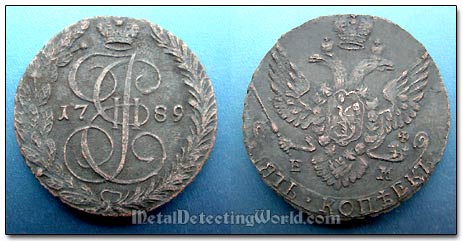My Search Programs for Minelab E-Trac and CTX 3030 Metal Detectors
Search Program #1: Level-1 Program Settings, page 10
SECONDARY DISCRIMINATION ZONES in Discrimination Patterns
The Secondary Discrimination zones mute the detector's responses to a small range of targets (like hot rocks - see below). Resulting from modifying the Discrimination pattern according to current detecting conditions, such zones are added to the pattern as auxiliaries to a Primary Discrimination Zone - the largest black area in the Discrimination pattern, that mutes responses to a wide range of targets (like the area below the FE-17 line in my Discrimination pattern, which rejects all iron).
The Secondary Discrimination zones that might reject the good targets are subdivided into four categories:
1) Zones that eliminate responses to hot rocks, coke and slug
Because the FE-CO read-outs of hot rocks vary from one geographic area to another, there are no universal FE-CO values for the hot rocks to be easily rejected by the Discrimination pattern. The FE-CO readings of hot rocks usually correspond to various high-pitched tones, but audio responses to hot rocks are overextended having "blurry" edges, i.e. not as crisp and "solid" as responses to coins. And it is hard, sometimes impossible, to pinpoint the exact location of a hot rock (the Pinpoint mode "SIZING" allows to distinguish the pinpoint audio signals of hot rocks from other high-conductive targets).

If you encounter hot rocks during your search, you may want to mute the detector's responses to them. Before digging a hot rock out, first memorize its FE-CO numbers (coordinates in the Smartfind window) shown on the Pattern or QuickMask screen. Then recover the object, and if it is indeed a hot rock, manually blacken (reject) its FE-CO coordinates in your Discrimination pattern (see details on page 15). Find a few more hot rocks and check their FE-CO values. If these numbers are different (more than one type of hot rocks is present in your search area), reject them as well.
Or, before digging the target suspected to be a hot rock, just use the AUTO REJECT MODE (page 45 of the Instruction Manual) so that the Discrimination pattern would be automatically modified to reject the FE-CO values of a detected hot rock. The resulting rejected areas may vary in size and shape in the Discrimination pattern: they may be just small black squares (depending on the Edit Frame Size) on the FE-01 and FE-02 lines, or entirely blackened vertical CO-50 line, or whatever.
If you made a mistake, it is easy and not time-consuming to take any automatically added black spot out of the pattern. Just remember that modifying the Discrimination pattern "on the fly" in accordance to current conditions always pays off!
Sometimes, one has to sacrifice one's "audio comfort" for a chance of detecting large silver or copper coins responding with FE-CO values being similar to the hot rocks' FE-CO coordinates. Of course, this approach should not be taken when dealing with numerous junk targets of one type.
A good example of such a sacrifice can be given with another Level-1 Discrimination pattern which I use for detecting coins in Eastern Europe.
Level-1 Discrimination Pattern for Coin Shooting in Eastern Europe

This pattern differs from the previous one only by a wider gap - accepted area, on the blackened FE-01 line. The gap extends from CO-32 to CO-48 allowing to accept large silver and copper coins. In particular, a large 5-Kopek coin shown below has the 01FE-32CO coordinates which unfortunately correspond to the local hot rocks as well.

This Large 5-Kopek Coin Corresponds to FE-CO 01-32 Coordinates on E-Trac's Smartfind Window

So if I really want to have such coins in my pouch, I have no choice but to listen to many hot rock signals. Similar situations may arise when coke and slag are present in the ground and may be identified by the visual Target ID circuit with FE-CO values that match the FE-CO coordinates of some small milled coins and small bronze artifacts.
2) Zones that eliminate "iron falsing" caused by the "wrap around effect" (see description of this effect in my "E-Trac Field-Test Report" page 2)
In my Discrimination patterns, such a zone is represented either by the black FE-01 line by itself or in conjunction with the blackened FE-02 and FE-03 lines, with the white "CO-38 - CO-49" gap. Other zones can be the following: 1) a segment of the CO-01 line blackened from FE-17 to FE-35 or entire CO-01 line black, and 2) a segment of CO-50 line blackened from FE-17 to FE-35 or entire CO-50 line black.
3) Rectangular zone that rejects everything from the FE-17 line to the FE-28 line
This zone "harbors" FE-CO coordinates of 1) deep coins that are barely detectable due to their hard-to-reach deep locations in the ground - at the outermost boundary of the E-Trac's or CTX-3030's detecting range, 2) coins that are positioned in close proximity to ferrous objects, and 3) coins that are partially masked by the highly mineralized ground.
In Level-2 and Level-3 Discrimination patterns, this zone is accepted to allow the detector to respond to the coins mentioned above.
4) Zones that eliminate responses emitted by specific unwanted non-ferrous targets of one type such as pull-tabs, brass casings, aluminum wires, etc.
NOTE: Make sure that you do not accidentally modify your Discrimination pattern to reject good targets when you add the Secondary Discrimination zone(s) to it.